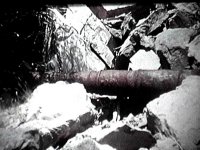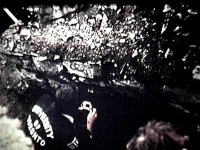

Archaeologists
Roger Grange
1965 - excavated walls, interior of Royal redoubt.
1968 - continued excavation - worked with masons to stabilize and reconstruct the remains,
what you see today.
Report - The work of these two summers is contained in a huge seven volume report,
Manuscript Report Series 46. The report includes descriptions of excavation,
drawings of artifacts, artifacts information in table form and historic maps.
Bruce Morton
1969 - worked on west curtian wall of redoubt, an area Grange did not have time to complete
in 1968.
Report - Manuscript Report Series 79.
Karlis Karklins
1970 - worked on the inner and outer defence walls, detached redoubt and gaillardon battery.
Report - Manuscript Report Series 39.
 Traditional excavations were undertaken in the interior of the redout, uncovering the remains
of various structures. In most cases only the bottom of the walls and the hearths remained,
and these are what have been stabilized. In the case of the rampart walls and the defence works,
these were not excavated in the traditional sense. What was still standing was investigated and
recorded by the archaeologist, and then stabilized so what you see today is basically what was
still standing of the original walls when the archaeological investigations took place in the 1960's.
Traditional excavations were undertaken in the interior of the redout, uncovering the remains
of various structures. In most cases only the bottom of the walls and the hearths remained,
and these are what have been stabilized. In the case of the rampart walls and the defence works,
these were not excavated in the traditional sense. What was still standing was investigated and
recorded by the archaeologist, and then stabilized so what you see today is basically what was
still standing of the original walls when the archaeological investigations took place in the 1960's.
The rampart walls and defence works were stabilized as were, but in some places it was necessary to do a bit of reconstruction or gap filling in areas were not to do so might have been hazardous.
Within the walls, the stabilization of the remains was more complex. Because of the various building phases, several layers remain in the south guard room. The archaeologists had to decide what should be excavated in order to reveal the remains underneath, and what should be left for stabilization even though unexcavated remains might remain underneath. Rather than to try to depict remains from a certain occupation or period in the stabilization, the archaeologists decided to leave and stabilize the remains from both occupations. Therefore, the stabilized ruins you see today are not representative of particular period, but are a combination both English and French remains.
Archaeology tells us that the area was originally one wide ramp leading down to the power magazine.
By 1701, according to the plan, it had been split in half, one side becoming a hanger or storage
area. Grange feels that this may have been done because the ramp, the access to the powder magazine,
would have been open to fire through the gun slits in the east curtian wall and that the construction
of the hanger would have provided protection for the ramp.
From excavation, we know that the hanger originally had a stone floor. However, the room was
deliberately filled in with dirt at a later time.
The English probably used the walls of the ramp and hanger to build their two storied guardhouse
on, perhaps filling in the hanger with dirt at this time. No archaeological remains of the
guardhouse were recovered.
Artifacts found during excavation include large quantities of grape shot (3,643) from the
ramp, fragments of brick and roofing tile, nails, and a fork.
Powder Magazine - through door at end of ramp, in the north-east bastion.
Archaeology tells us the sequence of construction;
1. Floor chiseled into the bedrock by French soldiers. Four worn iron chisels recovered
from this level.
2. Pads of mortar placed on bedrock, and walls and arch constructed on these.
Walls made from irregular shape rocks. Smoking pipes were found imbedded in the mortar of the
arch indicating that the French soldiers were smoking while working on the powder magazine.
3. A sub floor of sand and clay was laid over the bedrock.
4. A layer of mortar was laid over the sub-floor, serving as the floor for the French
use of the powder magazine.
5. The English laid down new layers of sand and mortar when renovating and repairing the
fort.
6. After the abandonment of the fort, the roof of the magazine fell in.
Remains of door jambs and wooden steps leading from ramp to floor of powder magazine
uncovered during excavating.
Artifacts found in the French levels of the powder magazine include the bone comb marked
Cir, 1698, which is part of the exhibit. The Chisels found in the bottom level were lost during
the excavation into the bedrock. The pipes imbedded in the arch during the construction by the
French were found on top of the English artifacts because the arch collapsed on top of the English
remains. Other artifacts from the French and English periods include nails, grapeshot, musket
balls and buttons.
South Gun Room - to the left of the entrance, built along the east and south curtian wall.
Archaeology revealed evidence of wooden floor joists and boards.
Remains of French and English hearths found in south end of room. The English hearth was
excavated and recorded, then the French hearth, which was directly underneath it, was uncovered
and stabilized.
French L-Shaped Barracks - built along the west and south wall of the interior of the fort.
Archaeology remains included only the bottom of the first-story stone walls.
Plans indicate the presence of two hearths, at the juncture of the two wings, but archaeology
revealed a third hearth built at the end of the north wing,into the north revetment wall.
English Block House - in the center of the interior.
Shown in 1762 and 1775 plans as two-story a building. Built partially on top of demolished
English L-shaped barracks; stablized ruins show wall of block house running over barracks wall.
Hearth remains on north side.
Additional English Barracks - built next ot the south guard room and sharing a common wall.
Shown as a store house in 1762 plan and additional English barracks in 1775 plan.
Walls are not well preserved and often just mortar stains remain to indicate original location.
Hearth in east wall; brick rubble from collapsed chimney and pile of ash in center of hearth
found during excavation;
French cordon strung from top of rampart walls found built into English construction hearth.
Rampart Walls.
Made of interior and exterior revetment walls, with earth filled in between. None of the
stabilized walls are full height so we cannot calculate original height of walls from archaeology.
Walls were built on a thick mortar footer laid on the bedrock surface. Built of local rock but
cordon and capstones made from imported cut limestone. The English repaired the walls when they
occupied the fort and sometimes they used the French cordon and capstones in repairs of other
part of the walls, or other structures, the hearth in the additional English barracks for example.
Upper and Lower Defence Walls - enclosed summit of Castle Hill to east and north of Fort.
They were found intact when investigated in 1970, although slumped and grown over.
They were originally about four feet wide and constructed without mortar, or dry laid.
In several places the wall jags out to take advantage and incorportate boulders. Although a wooden
palisade was shown in some plans, no evidence was ever found of this during the excavation.
Although in place by 1714, the wall found matches later English plans, and also French cordon
stones were found reused in the walls.
Detached Redoubt.
The excavation showed the same construction as the Upper and Lower walls. The presence of
some nails might indicate the presence of a wooden structure on the site.
Le Gaillardin Battery.
This was the earliest on the summit, 1692. Found intact, although collapsed and overgrown,
during the 1970 investigations. The interior was excavated, charcoal stains, nails, and wood
fragments revealed what might be the remains of gun placements.

